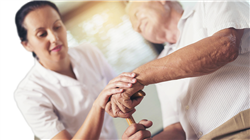University certificate
Scientific endorser

The world's largest faculty of nursing”
Introduction to the Program
Thanks to this Professional master’s degree 100% online, you will delve into the advanced management of pain and other complex symptoms, improving your skills in direct intervention and individualized care planning"

With a holistic approach that encompasses physical, psychological, social and spiritual aspects, Palliative Nursing plays a crucial role in the management of pain and other symptoms, ensuring that treatment aligns with the patient's preferences and values. However, the challenge of integrating humanization in health care remains a central issue, promoting compassionate and personalized care.
This is how this Professional master’s degree was created, which will provide nurses with an exhaustive preparation in the comprehensive care and management of patients with advanced and terminal illnesses. Therefore, the syllabus will cover a broad spectrum of knowledge, starting with learning the skills needed to provide compassionate care tailored to the individual needs of each patient.
Likewise, skills will be developed to work with the families of palliative patients, recognizing the importance of the family unit in the care process. In this regard, professionals will be able to communicate effectively and provide the necessary support for caregivers and other family members to better manage the stress and emotional burden associated with caring for a terminally ill loved one.
Finally, the latest scientific evidence related to the diagnosis and treatment of symptoms and syndromes prevalent in Palliative Care will be included. Therefore, graduates will delve into the most relevant therapeutic techniques, learning to use these tools in the daily follow-up of their patients. In addition, solid knowledge on specific nutrition for patients with advanced diseases will be integrated in order to improve prognosis and reduce complications.
In this way, TECH has implemented an exhaustive program, 100% online and flexible, adapted to the individual needs of the students, who will only need an electronic device with an Internet connection to access the didactic materials. In addition, it will be based on the innovative Relearning methodology, consisting of the reiteration of key concepts for the optimal and organic assimilation of the contents.
and organic assimilation of the contents.
You'll delve into the physical, emotional and spiritual needs of patients and their families, empowering you to provide more empathetic and compassionate care. Enroll now!”
This Professional master’s degree in Palliative Care for Nursing contains the most complete and up-to-date scientific program on the market. The most important features include:
- The development of practical case studies presented by experts in Palliative Care for Nursing
- The graphic, schematic, and practical contents with which they are created, provide scientific and practical information on the disciplines that are essential for professional practice
- Practical exercises where the self-assessment process can be carried out to improve learning
- Its special emphasis on innovative methodologies
- Theoretical lessons, questions to the expert, debate forums on controversial topics, and individual reflection assignments
- Content that is accessible from any fixed or portable device with an Internet connection
You will analyze the latest scientific evidence in Palliative Care for Nursing, thanks to the best didactic materials, at the forefront of technology and academia"
The program’s teaching staff includes professionals from the industry who contribute their work experience to this program, as well as renowned specialists from leading societies and prestigious universities.
The multimedia content, developed with the latest educational technology, will provide the professional with situated and contextual learning, i.e., a simulated environment that will provide immersive education programmed to prepare for real situations.
This program is designed around Problem-Based Learning, whereby the professional must try to solve the different professional practice situations that arise during the course. For this purpose, the students will be assisted by an innovative interactive video system created by renowned and experienced experts.
You will acquire fundamental competencies to provide high quality care, focusing on maximizing both quality of life and dignity in the dying process"

You will be specialized in the complexities of the pathologies faced by palliative patients, both oncologic and non-oncologic, equipping you to meet the unique challenges of this area"
Why study at TECH?
TECH is the world’s largest online university. With an impressive catalog of more than 14,000 university programs available in 11 languages, it is positioned as a leader in employability, with a 99% job placement rate. In addition, it relies on an enormous faculty of more than 6,000 professors of the highest international renown.

Study at the world's largest online university and guarantee your professional success. The future starts at TECH”
The world’s best online university according to FORBES
The prestigious Forbes magazine, specialized in business and finance, has highlighted TECH as “the world's best online university” This is what they have recently stated in an article in their digital edition in which they echo the success story of this institution, “thanks to the academic offer it provides, the selection of its teaching staff, and an innovative learning method aimed at educating the professionals of the future”
A revolutionary study method, a cutting-edge faculty and a practical focus: the key to TECH's success.
The most complete study plans on the university scene
TECH offers the most complete study plans on the university scene, with syllabuses that cover fundamental concepts and, at the same time, the main scientific advances in their specific scientific areas. In addition, these programs are continuously being updated to guarantee students the academic vanguard and the most in-demand professional skills. In this way, the university's qualifications provide its graduates with a significant advantage to propel their careers to success.
TECH offers the most comprehensive and intensive study plans on the current university scene.
A world-class teaching staff
TECH's teaching staff is made up of more than 6,000 professors with the highest international recognition. Professors, researchers and top executives of multinational companies, including Isaiah Covington, performance coach of the Boston Celtics; Magda Romanska, principal investigator at Harvard MetaLAB; Ignacio Wistumba, chairman of the department of translational molecular pathology at MD Anderson Cancer Center; and D.W. Pine, creative director of TIME magazine, among others.
Internationally renowned experts, specialized in different branches of Health, Technology, Communication and Business, form part of the TECH faculty.
A unique learning method
TECH is the first university to use Relearning in all its programs. It is the best online learning methodology, accredited with international teaching quality certifications, provided by prestigious educational agencies. In addition, this disruptive educational model is complemented with the “Case Method”, thereby setting up a unique online teaching strategy. Innovative teaching resources are also implemented, including detailed videos, infographics and interactive summaries.
TECH combines Relearning and the Case Method in all its university programs to guarantee excellent theoretical and practical learning, studying whenever and wherever you want.
The world's largest online university
TECH is the world’s largest online university. We are the largest educational institution, with the best and widest online educational catalog, one hundred percent online and covering the vast majority of areas of knowledge. We offer a large selection of our own degrees and accredited online undergraduate and postgraduate degrees. In total, more than 14,000 university degrees, in eleven different languages, make us the largest educational largest in the world.
TECH has the world's most extensive catalog of academic and official programs, available in more than 11 languages.
Google Premier Partner
The American technology giant has awarded TECH the Google Google Premier Partner badge. This award, which is only available to 3% of the world's companies, highlights the efficient, flexible and tailored experience that this university provides to students. The recognition as a Google Premier Partner not only accredits the maximum rigor, performance and investment in TECH's digital infrastructures, but also places this university as one of the world's leading technology companies.
Google has positioned TECH in the top 3% of the world's most important technology companies by awarding it its Google Premier Partner badge.
The official online university of the NBA
TECH is the official online university of the NBA. Thanks to our agreement with the biggest league in basketball, we offer our students exclusive university programs, as well as a wide variety of educational resources focused on the business of the league and other areas of the sports industry. Each program is made up of a uniquely designed syllabus and features exceptional guest hosts: professionals with a distinguished sports background who will offer their expertise on the most relevant topics.
TECH has been selected by the NBA, the world's top basketball league, as its official online university.
The top-rated university by its students
Students have positioned TECH as the world's top-rated university on the main review websites, with a highest rating of 4.9 out of 5, obtained from more than 1,000 reviews. These results consolidate TECH as the benchmark university institution at an international level, reflecting the excellence and positive impact of its educational model.” reflecting the excellence and positive impact of its educational model.”
TECH is the world’s top-rated university by its students.
Leaders in employability
TECH has managed to become the leading university in employability. 99% of its students obtain jobs in the academic field they have studied, within one year of completing any of the university's programs. A similar number achieve immediate career enhancement. All this thanks to a study methodology that bases its effectiveness on the acquisition of practical skills, which are absolutely necessary for professional development.
99% of TECH graduates find a job within a year of completing their studies.
Professional Master's Degree in Palliative Care for Nursing
The Professional Master's Degree in Palliative Care for Nursing created by TECH Global University is an exceptional opportunity to specialize in the comprehensive and compassionate care of patients with advanced illnesses. This graduate program, taught 100% online, focuses on providing you with the theoretical and practical knowledge necessary to provide quality care to patients in end-of-life situations, as well as to support their families in this difficult process. During this program, you will explore in depth the fundamental principles of palliative care, including pain management, symptom management, emotional or spiritual support, and effective communication with patients and families. You will learn the latest trends and best practices in the field of palliative nursing, based on scientific evidence and holistic approaches to care. One of the outstanding advantages of our degree is the combination of theory and practice, which will enable you to develop key skills and enhance your ability to provide compassionate, quality care to patients in advanced illness situations.
Master palliative care for nurses
The online mode of our Professional Master's Degree offers you the flexibility to study from anywhere and at any time, adapting your learning pace to your work and personal responsibilities as a nurse. You will have access to virtual classes taught by leading professionals in the field of palliative nursing, as well as interactive teaching resources and innovative learning tools. In addition, you will be supported by a team of specialized tutors and mentors who will guide you to maximize your learning and professional development in palliative care. Upon completion, you will earn a recognized postgraduate qualification that supports your training and experience in this crucial field of healthcare. This qualification will open up new career opportunities and enable you to make a significant contribution to the well-being and quality of life of patients in end-of-life situations. Take the opportunity to specialize in palliative care as a nurse - enroll now and become an expert in providing compassionate, quality care to those who need it most!







